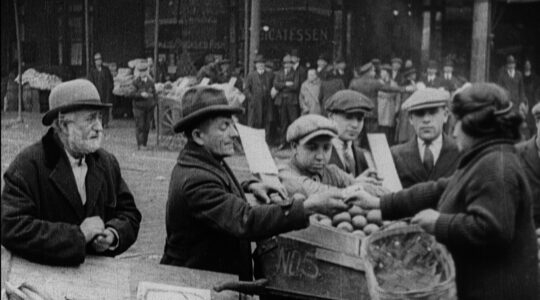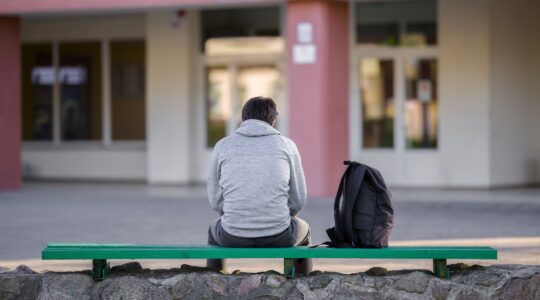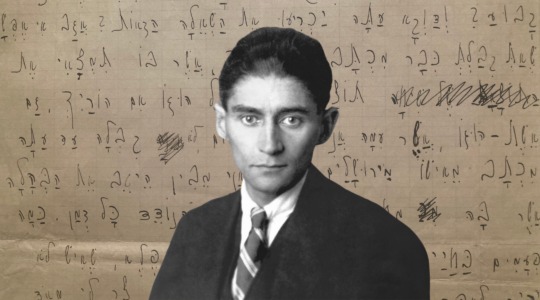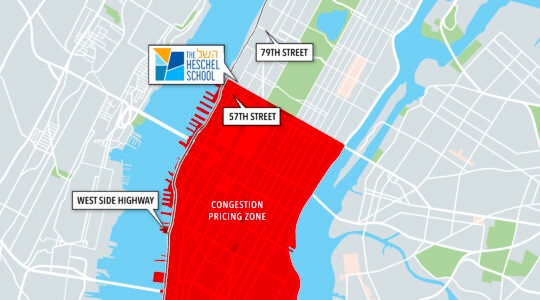When does history begin?
When explaining black America, in the wake of Rev. Jeremiah Wright, New York Times columnist Nicholas Kristof (March 30) looks to America’s “legacy of slavery, Tuskegee and Jim Crow,” context spanning 250 years.
But when it comes to Hebron, Kristof and B’Tselem — the Israeli human rights organization that Kristof relies on — history begins June 11, 1967, the seventh day of the Six-Day War, start of the occupation. That’s convenient, of course, because the story of Hebron — the world’s oldest Jewish city, according to the State of Israel — becomes too sympathetic if you start the day or the decades before that.
Kristof notes that Israel’s security “is nowhere more stifling than here in Hebron.” To protect
800 settlers, “the Israeli military has established a massive system of guard posts, checkpoints and road closures since 2001. More than 1,800 Palestinian shops have closed, in some cases the doors welded shut, and several thousand people have been driven from their homes.”
Not one word from Kristof or B’Tselem about Jewish buildings shuttered or Jews driven from their Hebron homes in 1929.
Kristof acknowledges, “The settlers see the issue very differently, emphasizing the continuing Palestinian attacks on them and noting that the security steps were put in place only in reaction to Palestinian terrorism during the second intifada a half-dozen years ago.”
And yet, Kristof writes, “In the Palestinian territories,” as if those territories are not disputed, “you see the worst side of Israel: Jewish settlers stealing land from Palestinians,” and also “the very best side of Israel. Israeli human rights groups,” such as B’Tselem that “relentlessly stand up for Palestinians … the most persuasive indictments of Israeli actions come from Israelis themselves.”
Kristof hoped that when American candidates “compete this year to be ‘pro-Israeli,’ let’s hope that they clarify that the one they support is not the oppressor that lets settlers steal land and club women but the one that is a paragon of justice, decency, fairness — and peace.”
If Kristof can go back to slavery in the 1800s, well, Rivka Slonim, Chabad emissary at the University of Binghamton, tells The Jewish Week that Slonims were living in Hebron in 1845. At what point does a settlement graduate to the dignity of being a neighborhood? How about a settlement that was established before 23 states were admitted to the Union?
On Oct. 13, 1912, the Times reported that Jews “owned 40 villages” in what is now Israel, including 23 villages in what is now the West Bank. In Hebron, there were yeshivas, Hadassah Hospital and a Jewish branch of a London bank making loans to “agriculturalists and traders.”
On July 12, 1914, the Times reported that Henry Morgenthau, U.S. ambassador to the Ottoman Empire, made an official visit to Hebron “where a triumphal arch spanned the road and Jewish schoolchildren sang songs of welcome.” Special dispensation from the Ottoman Empire allowed Morgenthau to enter the Cave of the Patriarchs, the first Jew to do so in centuries.
On Dec. 8, 1917, when British troops captured Hebron, the Times headlined that Hebron was where King David had lived, with the article adding that this was David’s capital for seven years, facts about Hebron that are rarely if ever mentioned anymore, in a journalistic atmosphere that is more about delegitimizing Israel than explaining it.
If slavery was America’s “original sin,” the 1929 ethnic cleansing was Hebron’s. For three days, Aug. 26-28, the Times ran daily stories and sidebars about an Arab attack that started on Shabbat morning at Hebron’s Slabodka Rabbinical College, killing 30. The toll of the dead and wounded from further rampages neared 120.
Kristof complains about the IDF presence in 2008. In 1929, JTA reported, and the Times quoted, “casualties mounted high because of the lack of a Jewish ‘self-defense’ group.”
The Times added, “Moslem Arabs seem to take particular delight in destroying Jewish religious institutions.” In the house of “A.D. Slonim, manager of the local branch of the Anglo-Palestine Bank, where more than 50 took refuge, 18 were killed…. The barbarity of the attackers knew no bounds.” Women were raped; the dead were “mutilated.”
The Times reported that Hebron had to be “evacuated by the Jewish inhabitants.”
A few days later, a Jewish burial society returned to Hebron, protected by British troops, to literally pick up the pieces. They worked from dawn into “the glaring rays” of afternoon. According to the Times reporter, “the examination [of the dead] was plainly visible and was burned into the memories of the newspaper men.”
In 1980, after the Camp David Accords that would have restored Palestinian autonomy to the West Bank, a position rejected by Yasir Arafat, a 23-year-old yeshiva student was murdered by Arafat’s Palestine Liberation Organization for the crime of walking in Hebron.
Ten days later, David Shipler reported (Feb. 10, 1980), “Israel’s cabinet supported in principle today the position that Jews have the right to resettle in the heart of the occupied city of Hebron where the last Jewish community was destroyed by Arab rioting in 1929.”
Shipler wrote that 56 buildings in Hebron were still registered to their Jewish owners from 1929. Many of the Jewish homes in Hebron remained uninhabited, reports Shipler, “not only because they realized that sooner or later the Jews had a chance of returning, but also because they thought the houses were haunted by the ghosts of Jews killed in 1929.”
Not a word from Kristof about how the Hebron “settlement” came to be. Kristof speaks of “shuttered” Palestinian buildings but not buildings shuttered and haunted by Jewish “ghosts.” To Kristof, the children of these ghosts are “the worst of Israel.”
NGO Monitor, a Jewish group in Israel, charged that B’Tselem is known for appropriating “human rights rhetoric for partisan goals.” B’Tselem begins its version of history after the 1948 war. That’s convenient because Arab armies in 1948 prevented Jews from returning to Hebron, and also expelled Jews from Jerusalem’s Jewish Quarter. According to B’Tselem’s Web site, the Jewish return to the Old City’s Jewish Quarter (site of the Western Wall) in 1967 constituted “land expropriation” from Palestinians, violating international law.
As NGO Monitor points out, “context is inconvenient for promoting B’Tselem’s political objectives, which would mean again removing the Jewish population from Hebron.” NGO Monitor also highlights B’Tselem’s frequent charge that Israel is “racist” and “apartheid” simply “trivializes legitimate Israeli anti-terror requirements,” implying that Israel’s concerns are motivated by ethnicity rather than terror dating back decades.
B’Tselem, founded in 1989 by Israeli academics, journalists, human rights activists and several Knesset members, is a recipient of the Carter-Menil Human Rights Prize, established by President Jimmy Carter.
On its Web site, B’Tselem openly acknowledges that it is partisan. It monitors Palestinian violations but “as an Israeli organization … the majority of [B’Tselem’s] efforts are directed at violations committed by our government on behalf of all of us.”
The New York Jewish Week brings you the stories behind the headlines, keeping you connected to Jewish life in New York. Help sustain the reporting you trust by donating today.




